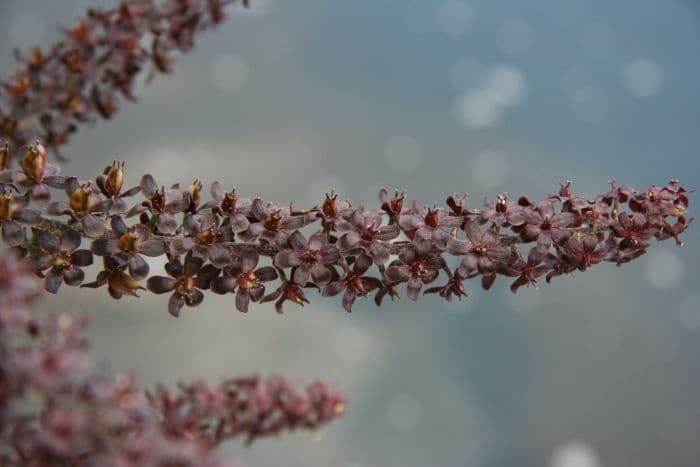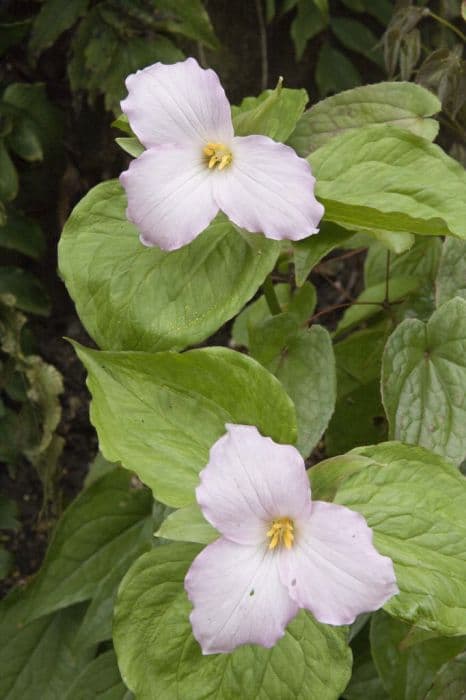Black false hellebore Veratrum nigrum

ABOUT
Veratrum nigrum, commonly known as black false hellebore, is a perennial plant with a distinctive and stout appearance. Featuring a clump of broad, pleated leaves that are deep green in color, the foliage often has a slightly corrugated texture giving it a very lush look. Each leaf spreads out from the base of the plant, and as they rise, they form a spiral arrangement, which is both robust and attractive. During the blooming period, the black false hellebore produces tall stalks topped with dense clusters of small, star-shaped flowers. The blossoms are typically a deep purplish-black or greenish hue, which contrast starkly with the lighter green of the vegetative parts. Individual flowers have a unique, three-lobed shape with six pointed tepals. The overall appearance of the black false hellebore presents a contrasting palette of colors and a mix of textures, from the folded leaves to the intricate flowers. The visual impact of the plant is complemented by its tendency to grow in lush, moist envrionments, often adding to the greenery of the area. Despite its attractive looks, it is important to note that this plant is toxic and should not be ingested.
About this plant
 Names
NamesFamily
Melanthiaceae
Synonyms
Black False Hellebore, Black Veratrum
Common names
Veratrum nigrum var. ussuriense, Veratrum lobelianum Bernh. not Bernh. ex Schult., Veratrum dahuricum (Turcz. ex Rupr.) Loes. f., Helonias nigra (L.) Ker Gawl., Melanthium nigrum (L.) Thunb., Veratrum schindleri O.Loes.
 Toxicity
ToxicityTo humans
The plant known as black false hellebore is highly toxic to humans if ingested. The toxicity of black false hellebore is primarily due to the presence of steroidal alkaloids, including veratridine and germitrine. If ingested, the plant can cause severe gastrointestinal symptoms such as vomiting and diarrhea. Additionally, it can lead to cardiac complications, manifested as bradycardia (slow heart rate) or arrhythmias. The nervous system may also be affected, potentially causing dizziness, headache, and visual disturbances. In severe cases, consumption can lead to organ failure, respiratory paralysis, or death. Even handling the plant can sometimes cause skin irritation or allergic reactions in some individuals.
To pets
Black false hellebore is also highly toxic to pets, including dogs and cats. The ingestion of any part of the plant can result in significant health issues due to the same steroidal alkaloids that affect humans. Symptoms of poisoning in pets can include vomiting, diarrhea, abdominal pain, extreme drooling, weakness, and depression. Severe cases can lead to cardiovascular disturbances like hypotension or cardiac arrhythmias, as well as seizures and respiratory failure. Rapid veterinary intervention is crucial to manage the toxicity and reduce the risk of fatal consequences following ingestion of black false hellebore by pets.
 Characteristics
CharacteristicsLife cycle
Perennials
Foliage type
Deciduous
Color of leaves
Green
Flower color
Purple
Height
4 feet (1.22 meters)
Spread
2 feet (0.61 meters)
Plant type
Herb
Hardiness zones
5
Native area
Europe
Benefits
 General Benefits
General Benefits- Erosion control - Veratrum nigrum has a robust root system which can help stabilize soil and prevent erosion.
- Habitat for wildlife - The plant provides shelter and food for various insects and animals.
- Ornamental use - With its striking foliage and dark blossoms, it is used for aesthetic purposes in gardens and landscapes.
- Pollinator attraction - It attracts bees and other pollinators, supporting biodiversity.
 Medical Properties
Medical Properties- Antihypertensive: Veratrum nigrum has been traditionally used to help lower blood pressure.
- Emetic: The plant has substances that can induce vomiting when ingested.
- Cathartic: It has been used as a strong laxative to treat constipation.
- Sedative: There is some indication that it may have a calming effect and could be used as a sedative.
- Antiparasitic: Compounds in Veratrum nigrum have been used to expel parasitic worms.
 Air-purifying Qualities
Air-purifying QualitiesThis plant is not specifically known for air purifying qualities.
 Other Uses
Other Uses- Veratrum nigrum, commonly known as black false hellebore, has been historically used as an insecticide; farmers would sometimes plant it among crops to ward off pests due to its toxic nature.
- In some regions, the roots of black false hellebore were used to poison arrow tips for hunting, capitalizing on the plant's toxic alkaloids.
- Black false hellebore has been used in traditional dyeing processes to achieve a yellow-green color, as it contains pigments that can tint textiles.
- The tall and robust stalks of black false hellebore can be used as a natural trellis in gardens for climbing plants.
- Due to its unpalatability, black false hellebore is sometimes planted as a natural perimeter barrier to deter herbivorous wildlife from entering gardens.
- In folklore, black false hellebore was believed to offer protection against evil spirits and was planted around homes for spiritual defense.
- Florists may use the dramatic leaves and stature of black false hellebore in floral arrangements and as a background plant in ornamental garden design.
- Some cultures have used the crushed leaves of the plant as a natural rodent repellent due to its strong scent and toxic properties.
- The distinct appearance of black false hellebore makes it an educational tool for botany studies, especially in discussions about plant defense mechanisms and toxicity.
- Photographers and artists sometimes feature black false hellebore in their work for its striking aesthetic qualities, particularly the deep coloration of its flowers and foliage.
Interesting Facts
 Feng Shui
Feng ShuiThe Black Hellebore is not used in Feng Shui practice.
 Zodiac Sign Compitability
Zodiac Sign CompitabilityThe Black Hellebore is not used in astrology practice.
 Plant Symbolism
Plant Symbolism- Deception: Veratrum nigrum, commonly known as Black False Hellebore, contains toxic alkaloids and can be mistaken for other less harmful plants. This property has led to its association with deception and mistaken identity.
- Protection: In some traditions, toxic plants like Black False Hellebore were believed to offer protection against evil spirits and negative influences due to their potent nature.
- Caution: The toxicity of Black False Hellebore serves as a natural warning to animals and humans alike, symbolizing the importance of caution and the need to avoid harm.
- Danger: The dangerous attributes of Black False Hellebore lead to its symbolism of hidden dangers, reminding us that not everything is as it appears on the surface.
 Water
WaterFalse Hellebore (Veratrum nigrum) should be watered deeply and thoroughly once a week during its growing season, ensuring the water reaches the root zone. The amount needed can vary depending on the soil type and weather conditions, but typically 1 to 1.5 gallons per week per plant is suitable. It's important not to over-water, as standing water or overly soggy soil can lead to root rot. During the dormant season, reduce watering frequency since the plant's water requirements decrease. Ensure the soil is partially dry before the next watering, as False Hellebore prefers a period of dryness between waterings.
 Light
LightFalse Hellebore thrives in partial shade to full shade conditions. The ideal spot for this plant would be an area that receives filtered sunlight or light shade throughout the day. Direct, harsh sunlight should be avoided as it can cause the foliage to scorch. A location under the canopy of tall trees or on the north side of a building would provide the best light conditions for the health and growth of Veratrum nigrum.
 Temperature
TemperatureFalse Hellebore is hardy and can withstand temperatures as low as 0°F and as high as about 70°F. The ideal temperature range for Veratrum nigrum is between 50°F and 65°F, offering a cool to moderate climate. It's important to protect the plant from extreme heat, as temperatures consistently above 70°F could stress the plant and affect its growth.
 Pruning
PruningFalse Hellebore doesn't typically require regular pruning. Pruning may be necessary to remove any dead or damaged foliage to maintain the plant's health and appearance. The best time for pruning Veratrum nigrum is in the late fall or early spring before new growth starts. Generally, pruning once per year is adequate to keep the plant looking tidy and encourage healthy growth.
 Cleaning
CleaningAs needed
 Soil
SoilBlack false hellebore, or Veratrum nigrum, thrives best in a moist, well-draining soil mix with high organic matter content. A pH ranging from 5.5 to 7 is ideal for this plant. An effective soil mixture can be prepared by combining loamy garden soil, peat, and perlite or coarse sand to improve drainage.
 Repotting
RepottingBlack false hellebore should be repotted every 2 to 3 years. Care should be taken to minimize root disturbance during repotting due to the plant’s sensitivity.
 Humidity & Misting
Humidity & MistingBlack false hellebore prefers moderate to high humidity levels. A range of 40-60% humidity is considered ideal for maintaining its health and vigor.
 Suitable locations
Suitable locationsIndoor
Grow in shade, keep soil moist, and ensure good air flow.
Outdoor
Plant in partial shade, enrich soil, protect from strong wind.
Hardiness zone
4-8 USDA
 Life cycle
Life cycleThe life of Veratrum nigrum, commonly known as Black false hellebore, begins with seed germination which occurs in moist, well-drained soil in partially shaded areas. After germination, the seedlings develop into juvenile plants with a basal rosette of leaves. Over several years, these rosettes grow larger as the plant matures vegetatively, storing energy in its rhizome. Upon reaching maturity, Veratrum nigrum produces upright flowering stems during the summer, which can reach up to 2 meters in height and bear numerous small, star-shaped, purple-black flowers. After pollination, typically by insects, the flowers develop into capsule-like fruits that release seeds when they dry and split open. The plant then enters a period of dormancy during the winter, with new growth resuming from the rhizome in the spring.
 Propogation
PropogationPropogation time
Spring-Early Summer
Black false hellebore, known botanically as Veratrum nigrum, is a plant that can be propagated by seed or by dividing its rhizomes. The most popular method of propagation for black false hellebore is by dividing the rhizomes in early spring just as the plant emerges from dormancy. This involves digging up the mature plants and gently separating the rhizome clumps into smaller segments, each containing at least one growth bud. These segments are then replanted into the soil at the same depth they were previously growing, spaced about 12 inches (approximately 30 centimeters) apart to allow enough room for growth. Dividing the rhizomes allows for the proliferation of the plants while ensuring genetic consistency within the propagated specimens.



